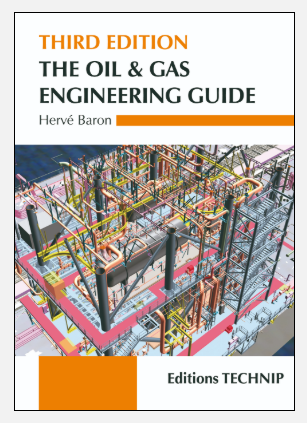The Oil & Gas Engineering Guide by Herve Baron
Contents
1. Project Engineering
2. The Design Basis
3. Process
4. Equipment/Mechanical
5. Plant Layout
6. Safety & Environment
7. Civil Engineering
8. Materials & Corrosion
9. Piping
10. 3D Model
11. Instrumentation and Control
12. Electrical
13. Off-Shore
14. The Overall Work Process
15. BASIC vs FEED vs Detail Design
16. The Project Time Schedule
17. Engineering Management
18. Engineering Control
19. Methods
20. Tools
21. Field Engineering
22. Revamping

Book Review
Having thoroughly read Oil and Gas Engineering Handbook by Hervé Baron, I found it to be an exceptionally practical guide focused squarely on engineering design and project execution for oil and gas facilities. The book’s strength lies in its methodical breakdown of FEED, EPC contracting, and commissioning processes, with particularly useful sections on process/piping design, materials selection (including corrosion resistance), and pressure equipment compliance (ASME/API). What stood out to me were the ready-to-use templates for procurement documentation and inspection test plans – tools I’ve actually applied in my own project work. While the coverage of construction safety protocols and pre-commissioning checks is comprehensive, I noticed the absence of modern project delivery methods like modular construction, which was disappointing. The emphasis on European (PED) and American (API) standards makes it versatile for international projects, though practitioners in digital transformation might find the lack of BIM/IIoT discussions limiting. Having used this as a reference on several occasions, I can confirm it’s most valuable for mid-level engineers transitioning into project roles, though it requires supplementation with more contemporary resources for cutting-edge practices.
Weblink
A Guide to the Project Management Body of Knowledge (PMBOK® Guide) – Seventh Edition and The Standard for Project Management
Contents
Part 1: Guide to Project Management
Introduction (Purpose of the Guide, Key Changes from 6th Edition, Alignment with PMI Standards)
Section 1: Project Management Fundamentals (Definition of a Project, Project vs. Operations, Role of the Project Manager)
Section 2: The 12 Principles of Project Management (New in 7th Ed.) (Stewardship, Team Collaboration, Stakeholder Engagement, Value Focus, Systems Thinking, Leadership, Tailoring, Quality, Complexity Management, Risk Management, Adaptability, Change Management)
Part 2: The 8 Performance Domains (Replaces Process Groups)
Stakeholder Performance Domain (Identification, engagement, and communication strategies.)
Team Performance Domain (Leadership, development, and dynamics.)
Development Approach & Life Cycle Performance Domain (Predictive, agile, and hybrid methodologies.)
Planning Performance Domain (Scope, schedule, budget, and iterative planning.)
Project Work Performance Domain (Execution, monitoring, and control.)
Delivery Performance Domain (Outputs, outcomes, and value delivery).
Measurement Performance Domain (Metrics, KPIs, and performance analysis).
Uncertainty Performance Domain (Risk, ambiguity, and resilience strategies).
Part 3: Tailoring, Models, Methods & Artifacts
Tailoring Guidance (Adapting approaches to project context).
Common Models (e.g., Complexity models, communication styles).
Common Methods (e.g., Agile estimation, SWOT analysis).
Common Artifacts (e.g., Charters, backlogs, roadmaps).
Appendices & References
(Glossary of Terms,Alignment with PMI Standards (e.g., Agile Practice Guide)

Book Review
The PMBOK® Guide 7th Edition represents a significant shift from its predecessor, moving away from a rigid, process-based framework to a more flexible, principle-driven approach. This edition emphasizes 12 guiding principles (e.g., stewardship, teamwork, and adaptability) and 8 performance domains (like stakeholder engagement and delivery), making it more applicable to agile, hybrid, and traditional project management methodologies. One of its standout improvements is the inclusion of tailored practices for agile and hybrid projects, addressing the growing need for flexibility in modern project environments. The guide also places greater focus on delivering value and outcomes rather than just adhering to processes, aligning better with business objectives. However, some critics argue that the reduced emphasis on detailed processes might leave less-experienced project managers seeking more structured guidance. Overall, the 7th Edition is a forward-thinking update that better reflects contemporary project management practices, though practitioners accustomed to the 6th Edition’s granularity may need time to adjust. This makes it particularly useful for engineers and project managers working in dynamic, iterative environments where adaptability is key.
